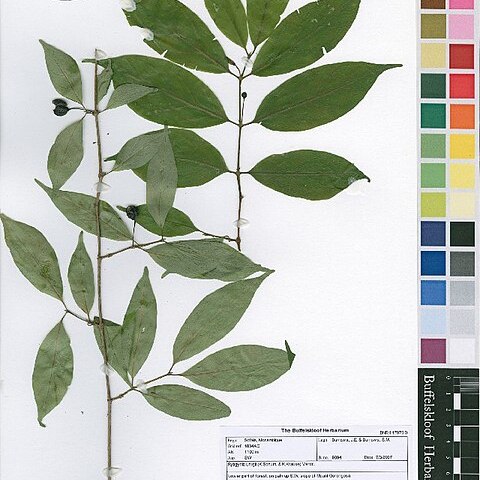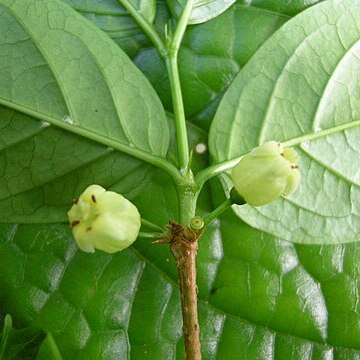Leaves mostly not fully developed at flowering time, 1.5–11 × 0.5–4.8(5.2) cm, elliptic to ovate, narrowly or abruptly acuminate at the apex, the tip usually rounded, cuneate, rounded or ± truncate at the base, glabrous save for obvious tufted domatia, or rarely sparsely pubescent, ± thin, not or only slightly discolorous; petiole 2–6 mm long; stipule bases 3–5 mm long, triangular or ovate, joined, densely pilose within, with a ± spreading often compressed subulate appendage 1–4.5 mm long, decurrent or sometimes completely lacking.
Corolla oblong, very obtuse in bud, the limb part characteristically much shorter than the tube; white to greenish-yellow; the limb usually remains ± closed; tube 4.5–5.5 mm long, mostly subglobose or urceolate-campanulate or sometimes ± cylindrical, with a ring of deflexed hairs inside; lobes mostly green, 2 × 1.5 mm, ovate, acute but not appendaged.
A shrub or small tree. It grows up to about 9 m tall. The bark is smooth. The leaves are narrowly oval and 2-11 cm long by 1-6 cm wide. The flowers are greenish-white or yellow. They are in groups of 1 or 2. The fruit is blue-black and about 1 cm across.
Inflorescences 1–2-flowered, rarely more; peduncle either ± suppressed or up to 6(10) mm long particularly in fruit; pedicels (2)6–12 mm long, often 15–23(30) mm long in fruit; bracts up to 1.5 mm long.
Stems pale chestnut-brown or purplish, longitudinally ridged, lenticellate, glabrous, the epidermis or bark wearing off to reveal pale undersurface.
Fruit blue-black, (7)9–10(?13 in life) mm in diameter, globose, containing 1–5 pyrenes; pyrenes 6–7 × 3–4 mm.
Shrub or tree 0.9–9 m tall, rarely scandent(?), laxly branched; bark smooth, pale brown to blackish-grey.
Calyx tube 1.2–1.5 mm long, the limb a rim about 0.2 mm long with obsolete or very small teeth.
Pollen presenter just exserted or exserted up to 2.5 mm, 2–5-lobed.
Style swollen at the base.
Ovary (2)3–5-locular.




